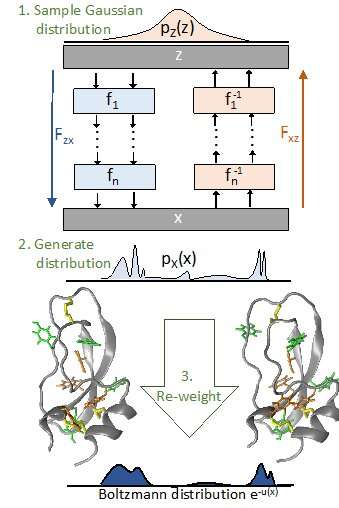Scientists develop a deep learning method to solve a fundamental problem in statistical physics

A team of scientists at Freie Universität Berlin has developed an Artificial Intelligence (AI) method that provides a fundamentally new solution of the "sampling problem" in statistical physics. The sampling problem is that important properties of materials and molecules can practically not be computed by directly simulating the motion of atoms in the computer because the required computational capacities are too vast even for supercomputers. The team developed a deep learning method that speeds up these calculations massively, making them feasible for previously intractable applications. "AI is changing all areas of our life, including the way we do science," explains Dr. Frank Noé, professor at Freie Universität Berlin and main author of the study. Several years ago, so-called deep learning methods bested human experts in pattern recognition—be it the reading of handwritten texts or the recognition of cancer cells from medical images. "Since these breakthroughs, AI research has skyrocketed. Every day, we see new developments in application areas where traditional methods have left us stuck for years. We believe our approach could be such an advance for the field of statistical physics." The results were published in Science.
Statistical Physics aims at the calculation of properties of materials or molecules based on the interactions of their constituent components—be it a metal's melting temperature, or whether an antibiotic can bind to the molecules of a bacterium and thereby disable it. With statistical methods, such properties can be calculated in the computer, and the properties of the material or the efficiency of a specific medication can be improved. One of the main problems when doing this calculation is the vast computational cost, explains Simon Olsson, a coauthor of the study: "In principle we would have to consider every single structure, that means every way to position all the atoms in space, compute its probability, and then take their average. But this is impossible because the number of possible structures is astronomically large even for small molecules. Therefore, the usual approach is to simulate the dynamical motion and fluctuations of molecules, and thus sample only those structures that are very likely to occur. Unfortunately, such simulations are often so computationally expensive that they cannot be done even on supercomputers—this is the sampling problem."
The AI method of Prof. Noé's team is a completely new approach towards the sampling problem. "Instead of simulating the motion of molecules in little steps, we find the high-probability structures directly, and leave the much larger number of low-probability structures behind. After that, the calculations are very cheap," explains Noé, "AI methods are key for this approach to work." Jonas Köhler, another co-author of the study and expert in machine learning methods, explains the approach with an example: "Imagine you place a drop of ink into a bathtub filled with water. The ink drop flows apart and mixes with the water. Now we want to find the ink molecules. If we do that by randomly selecting molecules from the bathtub, this would be very inefficient—we would have to empty the tub completely to find all the ink. Instead, using AI, we learn the flow of water which distributes the ink over time with an invertible neural network. With such a network, we can invert the flow, basically invert time, and then find all the ink molecules in the drop that we started with, without having to search the rest of the bathtub."
There are still many challenges to solve before the method of Noé's team is ready for industrial applications. "This is basic research," Noé explains, "but it's a completely new approach to an old problem that opens the door for many new developments, and we are looking forward to seeing those in the years to come."
More information: Frank Noé et al. Boltzmann generators: Sampling equilibrium states of many-body systems with deep learning, Science (2019). DOI: 10.1126/science.aaw1147
Journal information: Science
Provided by Freie Universitaet Berlin




















